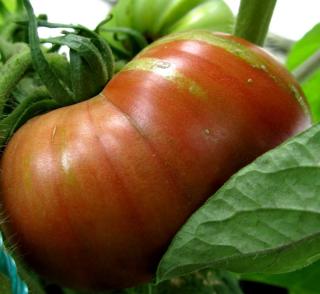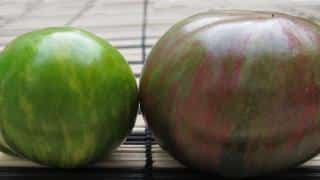

‘Black Zebra’ tomato: key facts
Botanical name – Solanum lycopersicum
Common name – ‘Black Zebra’ tomato
Family – Solanaceae
Type – fruit vegetable
Height – indeterminate
Planting distance – 20 inches (80 cm)
Exposure – full sun
Soil – cool, healthy, rich, soft
Planting – May
Harvest – July to September
The ‘Black Zebra’ tomato is a very original early tomato variety. It produces striped fruits. The brown-red skin is marked with dark green strips, nearly black in color. An annual native to California, the Black Zebra’s fruits are juicy and their taste is deliciously rich, typical of those black-colored tomatoes. Without any trace of acidity, their flesh is particularly well-suited to eating raw.
This cold-vulnerable plant should be started on a warm growing bed: sow your ‘Black Zebra’ from mid-February to May.
To learn more, read: Starting tomato seedlings off right
Transplant your young ‘Black Zebra’ tomato plantlets towards mid-May, when the last frost date has passed.
 Select a spot that in full sun for the planting, and make sure to amend the soil well before transplanting your seedlings in it.
Select a spot that in full sun for the planting, and make sure to amend the soil well before transplanting your seedlings in it.Since it’s an indeterminate growing variety, the Black Zebra requires staking as soon as it’s planted. Like most tomatoes, it’s a plant that’s vulnerable to the cold. It’s thus grown as an annual. Prefer spots for it that don’t reach scorching dry temperatures and in which the soil stays cool, light and rich. If you live in a place where the weather gets cold fast, it’s better to grow it in a greenhouse (or a tunnel).
To learn more, read: The right way to grow tomatoes
The ‘Black Zebra’ tomato is vulnerable to mildew, both the powdery one and the downy one.
You can start harvesting ‘Black Zebra’ tomatoes from your plants about 4 to 5 months after you’ve sown them. Harvest whichever fruits are ripe when you’re preparing your meals, anytime from from July to September. Only harvest whichever fruits are perfectly ripe.
After the harvest, Black Zebra tomatoes will keep in the vegetable rack in your refrigerator for a few days. You can also spread the fruits out on a tray in the open air. Best, of course, is to eat them on the same day you’ve picked them! This tomato is also perfectly suited to being cooked and preserved in airtight jars.

Compared to green zebra, the black one tastes a bit sweeter and richer.